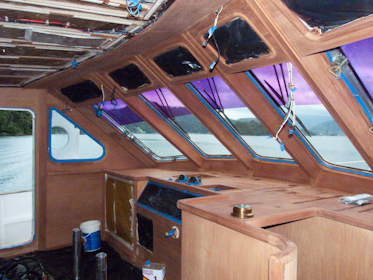Question
I'm doing some work in coastal NC (on the Currituck Sound), adding small cabinets here and there. The kitchen I’m working on is beautiful until you see all the lifting of the topcoat. Where the panel meets the frame, and at most stile/rail joints (doors and ends) the finish has started to flake off. He (the homeowner) said he used vinyl sealer and some MLC precat topcoat. The cab shop said they would fix it, decided not to, and now they are in a law suit. It’s a 30K plus job (kitchen, vanities, wet bar, etc.) and now it doesn’t looks so well.
He's had several people look at it, and wanted a quote from me to fix it to give his lawyer. This has gone on for 18 months, and the home owner tried to resolve without courts, but the old shop quit returning calls. Does anyone have any ideas what the problem could be?
Forum Responses
(Finishing Forum)
From contributor W:
Can you get an idea when the problem started in relation to the time it was first finished and installed? I know it has been at least 18 months now but what was the time involved before then?
Possible culprits: sealer applied too soon after stain (not likely); no vinyl sealer between glaze and topcoat (may or may not cause problem); coatings applied outside of application time windows (waiting too long - most likely); no scuff sanding between coats; incompatible stain/topcoat combination; individual coats applied too thickly resulting in loss of flexibility in the dry film; not applying finish within mfr's recommended temperature range (usually too cold). These kinds of problems usually occur when a shop is busy, and trying to complete a job (or jobs) too quickly, and cuts out steps in the finishing scheme (scuff sanding, dust removal, vinyl sealer).
This is an expensive problem to fix correctly. Stripping (catalyzed finishes) is labor intensive and usually not cost effective, and may result in future adhesion problems. This usually means re-fabricating all the doors on a job (not just the ones presently showing failure).
I'm amazed how often I see this type of failure occurring. It often is seen first on the doors beneath the sink where some moisture gets in, but also is aggravated by changes in humidity.
Catalyzed finishes, by their nature, are not terribly flexible, and shrinking and swelling cause an initial crack to occur, and the poorly-adhered finish begins to peel off. Proper use of vinyl sealer increases system flexibility, and helps to avoid this problem.
What is it Magnalac? Your humidity on the coast there is probably the major culprit. Once water (moisture) works itself under the finish, then it will cause it to lift (fail) along with high temperatures around the stove, dishwasher and sink. Most likely the edges of the doors were not rounded off and therefore a light coating was all that was on there which means very little protection from moisture and heat. The wood at the joints could have had a higher than desired moisture content and when the controlled temperature allowed the moisture to be released then it could have caused what it did at the joints.
Like I said there is any number of reasons as to why it failed. After the problems are sanded, there may be color work involved, but that shouldn't be a problem. Do that, then vinyl seal and top coat. I would find out if you can what stain and top coat was used.
Any kind of fix its just might work for the moment, but not the long run. This time around make sure the moisture content of the wood falls within standards. Allow all products to fully dry before going on to the next step. Thin your material according to the manufacturer’s specifications.
Apply the coating within the temperature range indicated by the manufacturer’s specifications. Don’t exceed the mill thickness as per the manufacturer’s recommendations. Make complete finish samples and complete the project using the same steps as were used on the samples.
Contributor W - the problem started about 3 months after install (I think he said it was summer) on a "couple" of doors and then gradually moved around the whole kitchen. I believe the wet bar was installed (thus probably finished) in a different phase. No problems there. And yes, they should have repaired (or replaced) the doors at first. They wanted to run small beaded trim (attached with hot melt glue) around the panel, but then the stile/rail joint started to go and that idea faded away.
Contributor A - knowing his operation I'm sure he was behind in production and in a hurry. I’m not really sure what ML product he used. I think I'll tell him if he wants the warranty I'll have to remake the doors and panel ends. Euro box cabs with screwed on end panels should go pretty quick on install.
